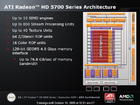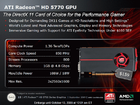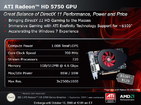- Joined
- Oct 9, 2007
- Messages
- 47,164 (7.57/day)
- Location
- Hyderabad, India
| System Name | RBMK-1000 |
|---|---|
| Processor | AMD Ryzen 7 5700G |
| Motherboard | ASUS ROG Strix B450-E Gaming |
| Cooling | DeepCool Gammax L240 V2 |
| Memory | 2x 8GB G.Skill Sniper X |
| Video Card(s) | Palit GeForce RTX 2080 SUPER GameRock |
| Storage | Western Digital Black NVMe 512GB |
| Display(s) | BenQ 1440p 60 Hz 27-inch |
| Case | Corsair Carbide 100R |
| Audio Device(s) | ASUS SupremeFX S1220A |
| Power Supply | Cooler Master MWE Gold 650W |
| Mouse | ASUS ROG Strix Impact |
| Keyboard | Gamdias Hermes E2 |
| Software | Windows 11 Pro |
The beans are spilled on the final specifications of AMD's "Juniper" mid-range GPU architecture, and the two SKUs based on it, namely the ATI Radeon HD 5770 and Radeon HD 5750. Leaked alleged company slides on XtremeSystems Forums, reveal exactly how Juniper is a 50% downsizing of Cypress' machinery, in having half of nearly all its vital-statistics, if you may. Juniper features 10 SIMD engines physically, amounting to 800 stream processors. It holds 40 texture memory units (TMUs), and 16 raster operation units (ROPs). With a 128-bit memory interface churning out up to 76.8 GB/s of memory bandwidth by utilizing 4.8 GT/s GDDR5 memory chips, the fact that Juniper is half of what Cypress stands for specs-wise, becomes clear.
In the next two slides are pictured and detailed the two SKUs based on the GPU. The ATI Radeon HD 5770 is the top-end implementation, which makes use of all the components present on the GPU. With a core clock-speed of 850 MHz, and memory speed of 1200 MHz, the GPU churns out a shader compute power of 1.36 TFLOPs. The idle and max board powers are rated by AMD at 18W and 108W, respectively. It becomes clear that AMD is eying the US $150 price point with this part. The Radeon HD 5750 on the other hand, has one SIMD engine disabled, and eds up with 720 available stream processors. It comes with 1 GB or 512 MB of GDDR5 memory, and clock speeds of 700 MHz core, and 1150 MHz memory (4.6 GT/s). With these, the Radeon HD 5750 manages a shader compute power figure of 1.008 TFLOPs. The rated board power consumption figures have also come down on this one, with 16W idle, and 86W max. This one targets the $109 (512 MB) and $129 (1 GB) price points. Both accelerators are DirectX 11 compliant, and support ATI Eyefinity technology supporting up to three 2560 x 1600 pixel display heads. According to the slides, they should be unveiled this Tuesday the 13th.



View at TechPowerUp Main Site
In the next two slides are pictured and detailed the two SKUs based on the GPU. The ATI Radeon HD 5770 is the top-end implementation, which makes use of all the components present on the GPU. With a core clock-speed of 850 MHz, and memory speed of 1200 MHz, the GPU churns out a shader compute power of 1.36 TFLOPs. The idle and max board powers are rated by AMD at 18W and 108W, respectively. It becomes clear that AMD is eying the US $150 price point with this part. The Radeon HD 5750 on the other hand, has one SIMD engine disabled, and eds up with 720 available stream processors. It comes with 1 GB or 512 MB of GDDR5 memory, and clock speeds of 700 MHz core, and 1150 MHz memory (4.6 GT/s). With these, the Radeon HD 5750 manages a shader compute power figure of 1.008 TFLOPs. The rated board power consumption figures have also come down on this one, with 16W idle, and 86W max. This one targets the $109 (512 MB) and $129 (1 GB) price points. Both accelerators are DirectX 11 compliant, and support ATI Eyefinity technology supporting up to three 2560 x 1600 pixel display heads. According to the slides, they should be unveiled this Tuesday the 13th.



View at TechPowerUp Main Site










